Sunday, June 6
Steve: This was a day that we had talked specifically
about six months ago when we first started planning our trip to Tanzania.
We still remember speaking with Judy at Thomson Safaris and listening to her
tell us about the unique lifestyle of the Hadzas, one of the last hunter-gatherer
cultures left on earth. She told us that over 90% of all men who had lived
on this planet had been hunter-gatherers, and despite our hesitation over
something that (at the time) sounded way too adventurous for 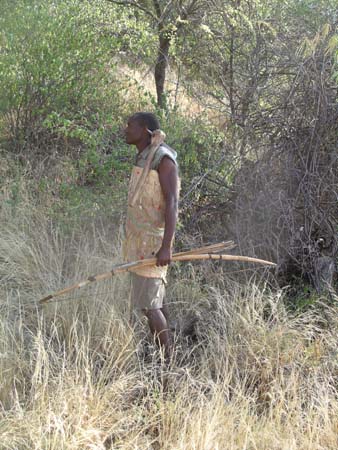 us,
she strongly urged us to visit the Hadza as part of our trip to Tanzania.
We also remember several family dinner discussions debating whether we should
include this in our plans, and how we eventually came to the reluctant conclusion
to do so. After today, we are very happy that this is the decision that we
made.
us,
she strongly urged us to visit the Hadza as part of our trip to Tanzania.
We also remember several family dinner discussions debating whether we should
include this in our plans, and how we eventually came to the reluctant conclusion
to do so. After today, we are very happy that this is the decision that we
made.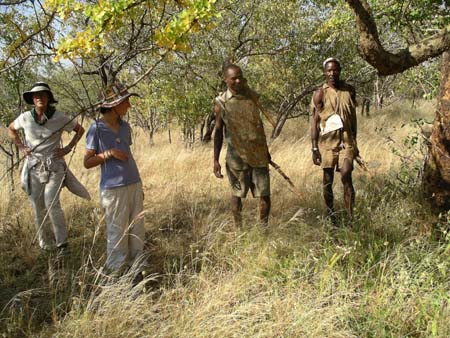
We began the day by hiking up the escarpment with Asini and his son Hamisi to hunt primarily for the Kirk's dik-diks that live in the wooded areas at the top. We walked with a certain sense of anticipation, while at the same time realizing that the likelihood of making Asini or Hamisi making a kill was very low. We have read that the vast majority of all hunting trips made by the Hadza are not successful. With the noise that all seven of us would make and the scent of so many of us in the air, we recognized that the chances were probably even lower.
The Hadza are the only people in Tanzania permitted to hunt wild animals
at will, and require no specific license. They normally hunt individually
according to no specific schedule. The men simply set out when they feel like
it, and normally eat their kills on the spot. They go for almost animal, except
for elephants which are too big to bring down. Their most com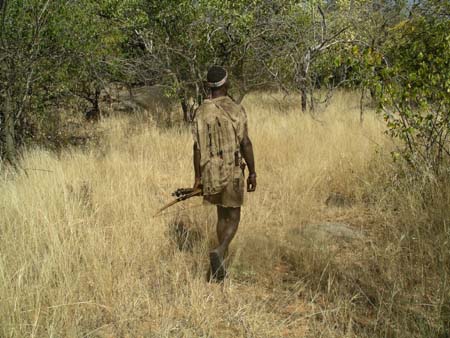 mon
large targets are zebra, giraffe, eland and gazelles. For these the Hadza
use poisoned arrows and must track the animals for up to two hours after shooting
while waiting for the poison to take effect. Their smaller prey includes all
types of birds, galago (also called bushbabies), hyrax and Kirk's dik-diks.
For these targets a simple wooden arrow or one with a metal point is used.
Asini told us that his favorite food is zebra, and that its meat is particularly
tasty.
mon
large targets are zebra, giraffe, eland and gazelles. For these the Hadza
use poisoned arrows and must track the animals for up to two hours after shooting
while waiting for the poison to take effect. Their smaller prey includes all
types of birds, galago (also called bushbabies), hyrax and Kirk's dik-diks.
For these targets a simple wooden arrow or one with a metal point is used.
Asini told us that his favorite food is zebra, and that its meat is particularly
tasty.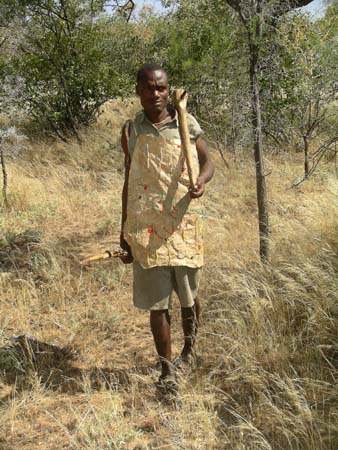
When a man makes a small kill, he normally lights a fire and eats his food right on the spot. Only rarely is anything brought back to camp. For larger kills, he leaves the dead animal temporarily to let others know so that the food can be shared with everyone. In these cases, the entire campsite is normally moved temporarily to the site of the kill. The Hadzas have very few physical possessions and their camps are very simple, and so moving from place to place is not considered a burden.
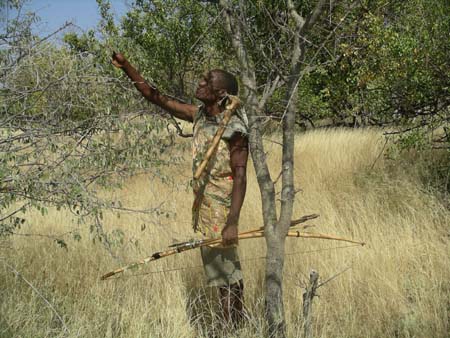 The
research that has been done on the Hadza suggests that they have no difficulty
finding enough food to survive, and that they are nutritionally healthy. Surprisingly,
80% of their diet consists of roots and berries, although they find these
to be their least satisfying foods. Despite the heavy concentration of vegetable
foods in their diet, the Hadza describe themselves as hunters.
The
research that has been done on the Hadza suggests that they have no difficulty
finding enough food to survive, and that they are nutritionally healthy. Surprisingly,
80% of their diet consists of roots and berries, although they find these
to be their least satisfying foods. Despite the heavy concentration of vegetable
foods in their diet, the Hadza describe themselves as hunters.
Men and women are independent in their search for food. While the men hunt,
the women collect berries and roots. We found it curious that the Hadza's
hunting methods result in the men having much more meat in their diet than
the women and children. Since small kills are the most common and the men
eat their food on the spot, the women and children back at camp are normally
left to eat the roots and berries that they collect during the day. 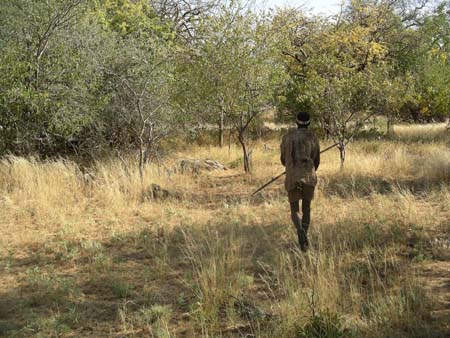
Additionally, we thought it was unusual that the Hadza so strongly prefer to hunt individually. Especially in cases where larger and highly desirable game such as zebra is spotted, it would seem that by working in teams and surrounding the target, the Hadza could significantly increase the chances of success. The answer to this question seems to simply be fact that this is how it's always been done, and with the Hadza getting enough food overall they see no reason to change. This is a culture that certainly hasn't changed altered over the years.
After we got to the top of the escarpment, Asini motioned for us to all walk as quietly as possible while he watched for signs of animals. In addition to looking and listening for actual targets, he also paid close attention to tracks and droppings on the ground. The terrain that we hunted in was mostly wooded with tall grass, perfect for most of the small animals to hide in. After about ten minutes, we all spotted a dik-dik in a small clearing about 50 yards away. We stood quietly as Asani began stalking the animal (that's what he is doing in the picture above), but from the beginning it was clear that the animal also saw us and he ran away before Asani could get off a shot.
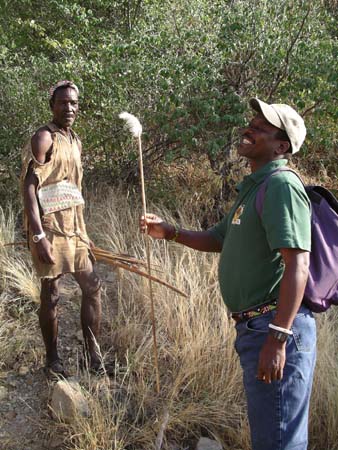 Asani
uses a stick with a small feather on the end as a wind indicator for his hunting.
It's important to be downwind of a target so that the animal doesn't pick
up the human scent. Today the wind was swirling all around, and Asani explained
that this made things particularly difficult since the animals would probably
smell us from any direction that we approached.
Asani
uses a stick with a small feather on the end as a wind indicator for his hunting.
It's important to be downwind of a target so that the animal doesn't pick
up the human scent. Today the wind was swirling all around, and Asani explained
that this made things particularly difficult since the animals would probably
smell us from any direction that we approached.
We were amazed at how quietly Asani and Hamisi are able to walk even in areas
full of branches and leaves. Despite wearing their flimsy sandals made of
used tires, they are remarkably sure-footed and never seem to make any noise.
As hard as we tried, we were unable to step quietly and we were sure that
the animals could hear us coming from far away.
Asani took us to a small cave that the Hadza often use to rest during their
hunting. It's also a place where baboons and small mammals such as porcupines
sometimes can be found. We stopped here to rest, and watched a fascinating
demonstration of the Hadza's method for making fire. Asani used his palms
to rapidly spin a small wooden pole that was rested on a small piece of dry
wo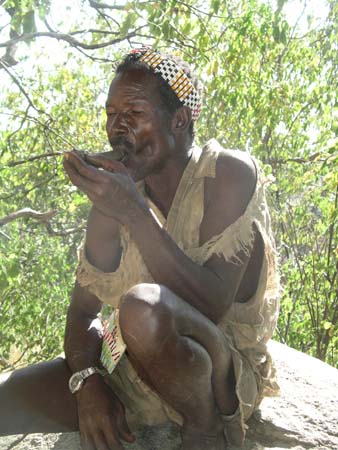 od.
In less than 15 seconds, he had generated enough heat to create a small spark
on the wood. He then put dried grass on the spark and blew heavily on the
wood, and soon we saw smoke coming from the grass. Flames were produced by
waving the bunch of smoking grass in the wind, and then twigs were added to
produce a real fire. The whole process took less than a minute, and seemed
amazingly easy. We were all invited to try for ourselves, but unfortunately
we failed miserably. The trick is in producing enough downward pressure on
the wood while spinning the pole in your palms.
od.
In less than 15 seconds, he had generated enough heat to create a small spark
on the wood. He then put dried grass on the spark and blew heavily on the
wood, and soon we saw smoke coming from the grass. Flames were produced by
waving the bunch of smoking grass in the wind, and then twigs were added to
produce a real fire. The whole process took less than a minute, and seemed
amazingly easy. We were all invited to try for ourselves, but unfortunately
we failed miserably. The trick is in producing enough downward pressure on
the wood while spinning the pole in your palms. 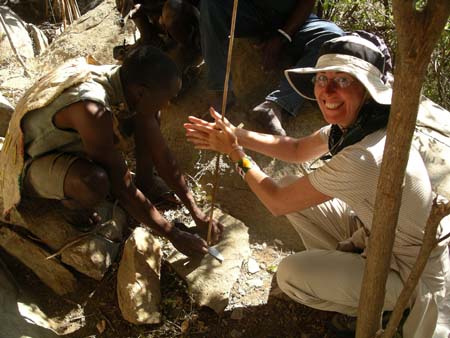 It
was definitely harder than it looked…
It
was definitely harder than it looked…
Although we had no meat to cook, Asani used the fire to light tobacco that he smoked from a small stone pipe. Smoking is fairly common among the men, and seems to be the one indulgence that the Hadza partake in. We learned from Asani that other than gambling (for arrowheads) and occasional dancing (normally part of a celebration following a large kill), the Hadza rarely participate in any forms of recreation or entertainment.
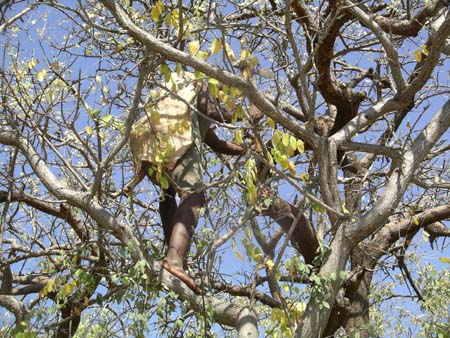 At
one point, Paula and I climbed a rock to get a view of the valley below, and
we spotted a pair of klipspringers on a rock just across a gulley. These animals
look like the dik-diks, but are somewhat larger. As soon as Hamisi made it
t
At
one point, Paula and I climbed a rock to get a view of the valley below, and
we spotted a pair of klipspringers on a rock just across a gulley. These animals
look like the dik-diks, but are somewhat larger. As soon as Hamisi made it
t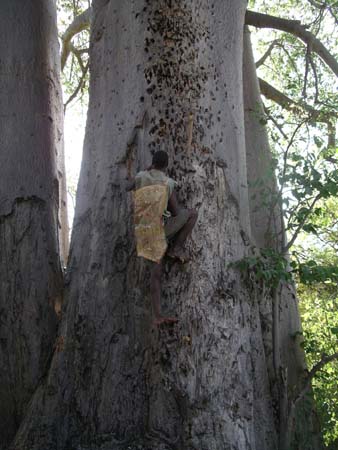 o
where we were standing, the klipspringers ran away. Nassibu's belief is that
the animals weren't scared of Paula and me because we have white skin, but
ran after seeing Hamisi because they have learned to associate the dark skin
of the Hadzas as danger.
o
where we were standing, the klipspringers ran away. Nassibu's belief is that
the animals weren't scared of Paula and me because we have white skin, but
ran after seeing Hamisi because they have learned to associate the dark skin
of the Hadzas as danger.
 On
our way back to camp, Hamisi spotted bees flying out of the branch of an acacia
tree, a sign of the honey that the Hadzas love. We then watched as Hamisi
amazingly climbed this tree full of long and very nasty thorns and used his
axe to break into the hive and retrieve large fingerfuls of tasty honey. We
initially wondered how he could do this without getting stung, and then learned
that these particular bees are very small and surprisingly they don't sting.
We were all offered tastes of the fresh honey, with Katie quickly deciding
that this was the sweetest she had ever eaten.
On
our way back to camp, Hamisi spotted bees flying out of the branch of an acacia
tree, a sign of the honey that the Hadzas love. We then watched as Hamisi
amazingly climbed this tree full of long and very nasty thorns and used his
axe to break into the hive and retrieve large fingerfuls of tasty honey. We
initially wondered how he could do this without getting stung, and then learned
that these particular bees are very small and surprisingly they don't sting.
We were all offered tastes of the fresh honey, with Katie quickly deciding
that this was the sweetest she had ever eaten.
Honey seems to be the only commodity that the Hadza can use for purchasing
the small number of physical possessions that they own. The honey also serves
as dowry, and the current going price for a wife is 60 liters.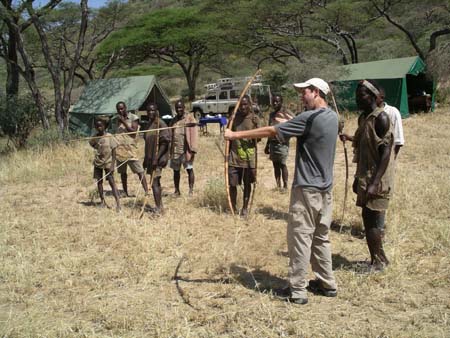
After arriving back at camp, David and I were offered the opportunity to
try our hands using the Hadza's bows and arrows. Using the wooden arrows,
we were invited into a fun game of target practice, with the objective being
a small water 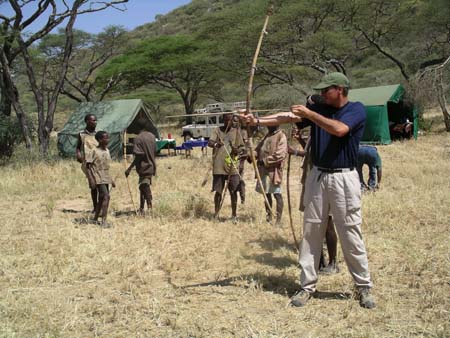 bottle
placed on the ground about 20 yards away. As hard as we tried, we never were
able to hit the bottle (although we came close several times). Meanwhile,
the Hadza made this look unbelievably easy, hitting the bottle more than 50%
of the time. Marabo, one of Asini's sons, was a particularly good aim and
hit the target every time he tried. One of his shots was so true that it went
right through the bottle and stuck in the ground on the other side.
bottle
placed on the ground about 20 yards away. As hard as we tried, we never were
able to hit the bottle (although we came close several times). Meanwhile,
the Hadza made this look unbelievably easy, hitting the bottle more than 50%
of the time. Marabo, one of Asini's sons, was a particularly good aim and
hit the target every time he tried. One of his shots was so true that it went
right through the bottle and stuck in the ground on the other side.
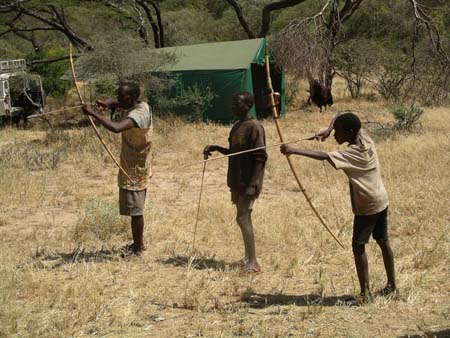
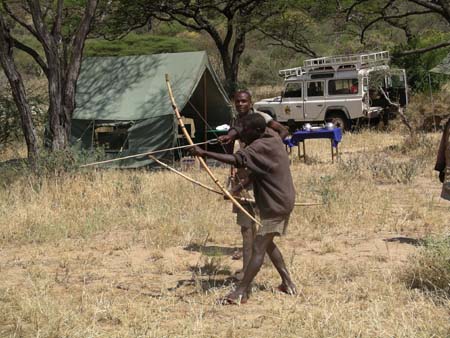
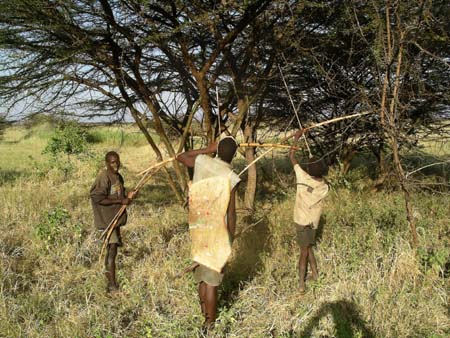
After resting this afternoon, we split into two groups. David and I accompanied Hamisi, Marabo and nine year-old Joseph (obviously his English name) for another hunting trip. Meanwhile, Paula and Katie went with Nassibu to join the women who were planning to dig and cook roots.
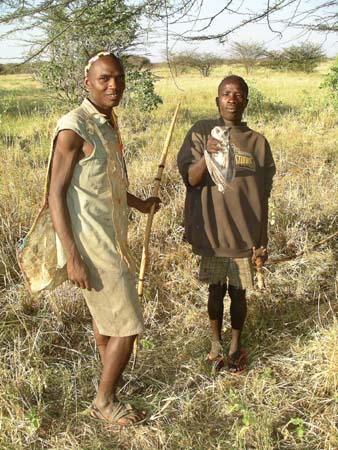 We
weren't sure what to expect with this hunting trip, but quickly found that
this time we would be much more focused on searching for targets in the trees
- primarily birds and small animals called bushbabies. Soon after leaving
camp, Marabo spotte
We
weren't sure what to expect with this hunting trip, but quickly found that
this time we would be much more focused on searching for targets in the trees
- primarily birds and small animals called bushbabies. Soon after leaving
camp, Marabo spotte d
an owl high in an acacia tree, and we were amazed when he hit the bird dead
on in a single shot using a wooden arrow. Joseph then hit the owl with another
arrow (we assumed to put it out of its misery), and was assigned the job of
climbing the tree to retrieve their kill. The acacia trees are loaded with
long thorns, and we couldn't believe how easily Joseph was able to climb to
the top (with no shoes on) and collect the owl.
d
an owl high in an acacia tree, and we were amazed when he hit the bird dead
on in a single shot using a wooden arrow. Joseph then hit the owl with another
arrow (we assumed to put it out of its misery), and was assigned the job of
climbing the tree to retrieve their kill. The acacia trees are loaded with
long thorns, and we couldn't believe how easily Joseph was able to climb to
the top (with no shoes on) and collect the owl.
 The
three boys soon spotted their next target in another tree, and quickly took
up positions at various spots looking up toward the highest branches. Although
we didn't see it at first, a small bushbaby was hiding near the top of the
tree. This is a very small animal, and given the height of the tree we didn't
see how they'd be able to hit it. However, the bushbaby had no chance - once
again, only a single shot
The
three boys soon spotted their next target in another tree, and quickly took
up positions at various spots looking up toward the highest branches. Although
we didn't see it at first, a small bushbaby was hiding near the top of the
tree. This is a very small animal, and given the height of the tree we didn't
see how they'd be able to hit it. However, the bushbaby had no chance - once
again, only a single shot 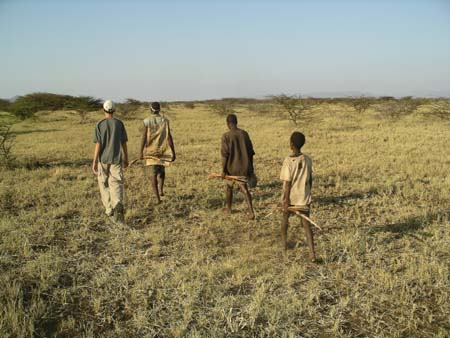 was
needed. David and I were absolutely amazed with the accuracy of these boys,
especially given the height of the tree and the need to shoot through the
branches and leaves.
was
needed. David and I were absolutely amazed with the accuracy of these boys,
especially given the height of the tree and the need to shoot through the
branches and leaves.
In total, the boys killed 4 bushbabies and one owl - hardly enough for a large dinner but certainly preferable (at least for them) to berries and roots. David and I tried hard not to feel sorry for their kills (we're not much the hunting type), keeping in mind the fact that this is merely how the Hadza survive. After we arrived back at the camp, the Hadza simply placed the owl and bushbabies directly on the fire, and we watched as they ate every little piece of meat off the bones.
 As
the boys enjoyed their small dinners, Asani sat by the fire and made an arrow
for us to take home as a souvenir. It was amazing to watch him straighten
a branch from a special bush b
As
the boys enjoyed their small dinners, Asani sat by the fire and made an arrow
for us to take home as a souvenir. It was amazing to watch him straighten
a branch from a special bush b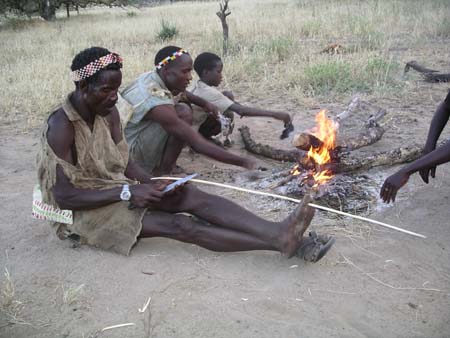 y
heating it in the fire and expertly using his teeth. The Hadza never waste
any parts of the animals that they kill - the arrow that Asani made for us
contained feathers from the owl that Marabo shot, wrapped in tendons from
a giraffe.
y
heating it in the fire and expertly using his teeth. The Hadza never waste
any parts of the animals that they kill - the arrow that Asani made for us
contained feathers from the owl that Marabo shot, wrapped in tendons from
a giraffe.
 While
we were hunting, Paula and Katie had a great time with the women doing the
more "womanly" activities. They started by helping the women pull
dead grass that was being placed on the outside of their homes. They then
walked a short distance to a large tree that was wrapped by a thick vine.
The women
While
we were hunting, Paula and Katie had a great time with the women doing the
more "womanly" activities. They started by helping the women pull
dead grass that was being placed on the outside of their homes. They then
walked a short distance to a large tree that was wrapped by a thick vine.
The women  then
got on their knees and used pointed sticks to dig into the soil around the
vine. The soil was very dry and rocky, and was hard to break up. After a great
deal of effort, the women reached the roots from the vine, often breaking
off small pieces that they smelled to make sure that they weren't rotten.
then
got on their knees and used pointed sticks to dig into the soil around the
vine. The soil was very dry and rocky, and was hard to break up. After a great
deal of effort, the women reached the roots from the vine, often breaking
off small pieces that they smelled to make sure that they weren't rotten.
 As
the women dug deeper, the roots got thicker and eventually the women all connected
their holes so that the entire root system wa
As
the women dug deeper, the roots got thicker and eventually the women all connected
their holes so that the entire root system wa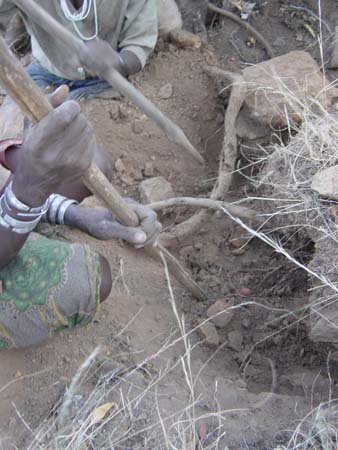 s
visible. They then broke off the very end of the roots - this is the only
part that they eat. To Paula and Katie, it appeared to be a very small reward
given the large amount of effort that was required.
s
visible. They then broke off the very end of the roots - this is the only
part that they eat. To Paula and Katie, it appeared to be a very small reward
given the large amount of effort that was required.
The roots were taken back to camp and placed directly on the fire. They cooked
very quickly, were peeled, and then passed around. Paula and Katie were surprised
to learn that the women simply chew the roots, sucking out 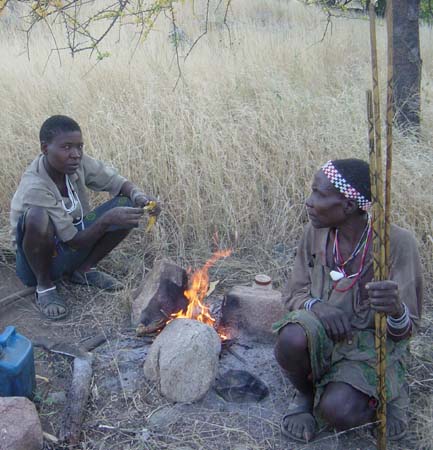 the
nutritious juices. They then spit out the roots. Paula and Katie tried some
for themselves, quickly concluding that the juice from the roots has no discernable
taste.
the
nutritious juices. They then spit out the roots. Paula and Katie tried some
for themselves, quickly concluding that the juice from the roots has no discernable
taste.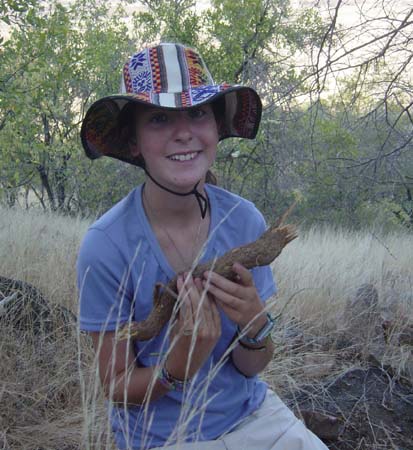
Finally, after a wonderful day, we were treated to another great dinner and then sat out to enjoy the campfire under a clear star-filled sky. This was our last night of camping in Tanzania. We are not really a "camping" type of family, and have joked about how we have been spoiled with hot meals, showers and other luxuries not usually associated with camping experiences.
Tomorrow we will be driving back to Gibbs Farm, and plan to relax in the afternoon before heading the following day to Tarangire Park for more wildlife viewing.
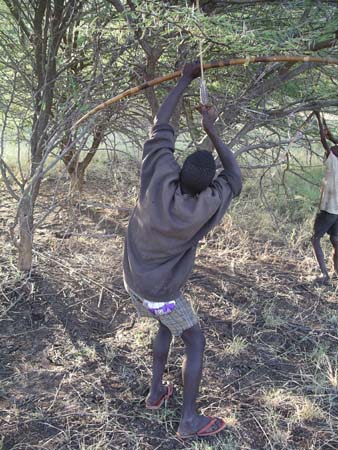
David's Daily Dump: Hunting with the Hadza. One of the things that we couldn't help but admire was the amazing hunting skills of the Hadza tribe. We were lucky enough to be able to join some men during their daily hunts. It was really incredible to watch these people hunt, and to realize that they were not hunting for fun, but for survival.
Before I talk about what happened on our hunts, I should explain what the Hadza use as weapons. This tribe actually uses a bow and arrow, which we later found to be quite effective and deadly. They make everything by hand, and use very little material that cannot be found within five minutes from their homes. The first thing we learned about was the arrows. We noticed that each man carried around three different types of arrows. One had a sharpened wood tip used for small game like birds and dik-diks (tiny antelope). Another had a metal tip used for middle-sized game, while the last had a metal tip which was covered in poison from a common tree which killed large animals such as zebras and giraffes. The arrows are made from a wood that they use to build houses, animal tendon, and feathers from the birds they kill. To make the metal arrows, they buy nails from a market, partially melt them, and pound them into the shape they need.
One of the elder men made a wooden-tipped arrow for us, and showed us the
unique process. First he found a live tree, and cut off a branch at the right
length. Of course, the stick was not perfectly straight, so to our surprise,
he actually put it in the fire for a few seconds, and bent it with his teeth!
In fact, you can still see the tooth marks in the arrow. He repeated biting
and bending the pie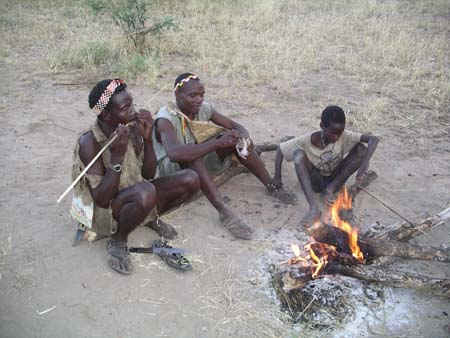 ce
of wood until it was perfectly straight. Then he sharpened the end with his
knife, and pulled out giraffe tendon, which was used as string. He stuck the
whole piece in his mouth and chewed on it for several minutes. Once it was
wet enough, he started to tie on the feathers of an owl (which had been killed
10 minutes before) to the end. He used several long pieces until the feathers
were on tight and very sturdy. Finally he cut the notch in the end, where
the string of the bow would go, and polished it with his knife. It was so
cool!
ce
of wood until it was perfectly straight. Then he sharpened the end with his
knife, and pulled out giraffe tendon, which was used as string. He stuck the
whole piece in his mouth and chewed on it for several minutes. Once it was
wet enough, he started to tie on the feathers of an owl (which had been killed
10 minutes before) to the end. He used several long pieces until the feathers
were on tight and very sturdy. Finally he cut the notch in the end, where
the string of the bow would go, and polished it with his knife. It was so
cool!
The bows that the Hadza use are also very fascinating. They vary in size, but most are about 3-4 feet long. The wood used is carved into a perfect curve, and is supported by pieces of tendon or metal wrapped around the middle. The strings are made from animal tendon, and wrapped around the ends many times, ensuring maximum strength and tightness.
The hunts that we went on were absolutely incredible! I cannot explain what
it was like to be out in the middle of nowhere (seriously, the nearest town
was over 70 miles away!) hunting with one of the last hunter-gatherer tribes
on earth. In all, we went out twice, once in the evening and once in the morning.
The whole family came along in the morning while Dad and I went without the
women in the evening. 
Although the morning turned out unsuccessful, it was fun to watch the whole hunting process. We climbed up a near by escarpment searching mostly for dik-diks and other small animals. The men also took many looks from the top into the open plains before us, searching for zebras and antelope. After half an hour of walking, we reached the top, and spotted a dik-dik in the shrubs. We all froze in our tracks and watched intently as the Hadza man moved quietly forward with his bow and arrow aimed. The animal soon spotted us and dashed into the grasses before he could shoot.
We moved on, and spotted nothing else before our stop at a cave. There the men made a fire from twigs, and started smoking tobacco. The whole family tried to start a fire, and we all utterly failed. Soon afterwards, Mom and Dad spotted a klipspringer on the rocks, and the men closed in. Just before firing, the antelope turned and galloped out of sight. We were 0 for 2 and the men were getting hungry.
After a while, to the men's pleasure, we found honey. One of the men (there were two hunters with us) climbed up a thorny tree with an axe, and hammered into the trunk. Luckily, the bees are tiny and don't sting, so we weren't attacked. Finally he struck gold, and took finger full after finger full of the fresh delicious honey. Then we started hunting again, and found nothing else on the way back to camp. Once back at the camp, we learned there would be another hunt in the evening, so Dad and I decided to try our luck once more…
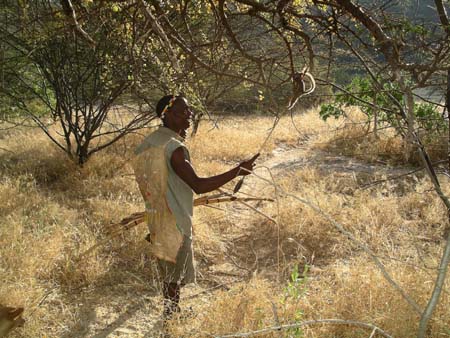 This
time, we were very successful, very successful indeed… In all the Hadza
killed one spotted eagle owl, and four lesser galagos (also called bushbabies)
on the second hunt. I have to say that although it was super cool, it was
also kind of sad. Most of the animals we killed had an arrow through them
and were still squirming around as they brought them down from the trees.
They all looked scared and helpless as they died. But we realized that it's
part of life for the Hadza.
This
time, we were very successful, very successful indeed… In all the Hadza
killed one spotted eagle owl, and four lesser galagos (also called bushbabies)
on the second hunt. I have to say that although it was super cool, it was
also kind of sad. Most of the animals we killed had an arrow through them
and were still squirming around as they brought them down from the trees.
They all looked scared and helpless as they died. But we realized that it's
part of life for the Hadza.
Anyway, the first thing they (this time it was two men, a nine year old boy
who was a very good hunter, Dad, and me) spotted was an owl which was asleep
in a tree. One of the men tiptoed under the tree with his bow and arrow pointed
up, aimed, and hit it right through the chest. The arrow just about went all
the way through him. The aim was incredible! There were branches and twigs
everywhere, and the owl was fairly high up in the tree. When the arrow struck
the owl, he didn't die and flapped his wings helplessly as the young boy hit
him a second time in the wing. Again the owl didn't die, and the boy climbed
up the tree to retrieve it. The men had to strangle it and hit it's head on
a rock to put him out of his misery. 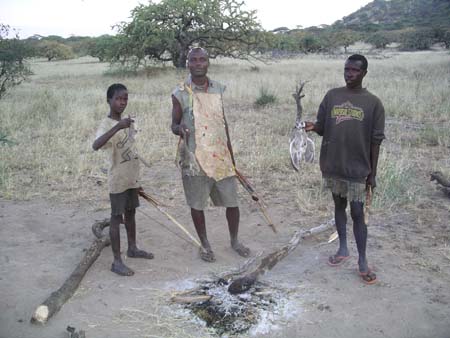
Next, the men spotted galagos (tiny, 8-inch long, creatures that live in the trees) in a tree nearby. There were two of them, and they started jumping through the branches as soon as they spotted the Hadza. Eventually they stopped moving, and the arrows flew, hitting the animals square in the chest. The creatures would fly through the air, landing painfully in another tree. Even with arrows half way through them, the galagos fought for survival as the boy climbed the tree again to get them. We couldn't help but marvel at the spectacular aim of the men. They killed three more galagos this way, and then headed back to camp. The Hadza men roasted the animals on the fire and dug in. After satisfying themselves, they chatted and headed back to their own homes.
I remember first talking about visiting the Hadza over dinner last December, and thinking to myself "this is crazy!" I was dreading this visit for most of the second trip, but slowly got excited about it. I was scared of the camping, long bumpy car ride, and time we would be spending with these very different people. But all in all, it was unbelievable experience that I will surely never forget. I not only learned that taking risks and chances can be beneficial, but also that no matter how different someone's culture or way of life is, there is always a way to recognize and understand who they really are and that in many ways they are no different from us.
